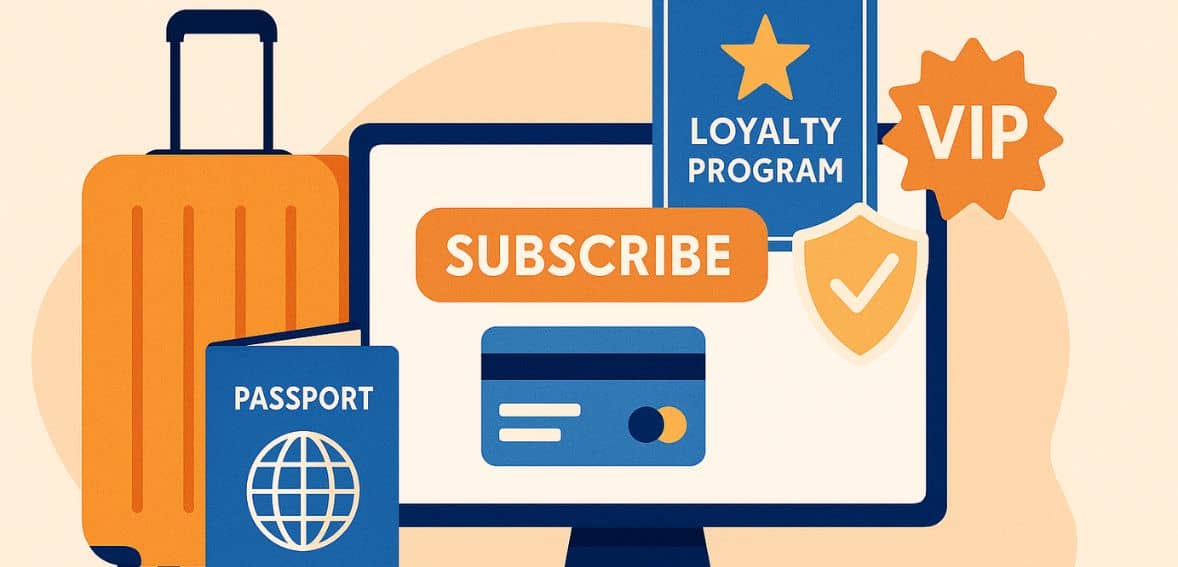
By alphacardprocess July 31, 2025
The way we experience travel is evolving—and so is the way we pay for it. Loyalty was defined for decades by hotel points and frequent flyer miles. The modern consumer, however, demands more than sporadic benefits. They are drawn to seamless value, customized experiences, and assured priority—all without any catches or unpleasant surprises. Subscription-based travel agencies can help with that.
The recurring payment model is building a loyal customer base that is prepared to pay for regular convenience, whether it be priority boarding, lounge access, or carefully planned luxury vacations. By using this payment model, travel agencies can build dependable revenue streams, strengthen client relationships, and transform their brand from transactional to transformative.
The Shift Toward Travel Subscription Services and Membership Models

The subscription model has now permeated the travel industry after being made popular by services like Netflix and Spotify. Today’s travelers are prepared to pay up front and repeatedly for the control, convenience, and exclusivity they desire. Programs like early check-ins, free upgrades, no blackout dates, and flexible cancellations are being introduced by airlines, hotel chains, and travel concierge services.
Customers’ convenience isn’t the only reason for the change. It promotes brand loyalty and provides travel agencies with a new source of steady income. It turns the impromptu aspect of travel into something predictable, cozy, and, for companies, sustainable.
Why Recurring Payments Are the Backbone of Travel Subscriptions
Travel subscriptions are structured around recurring payments. They guarantee the continuous exchange of value between the provider and the customer. Travelers are more likely to stay subscribers and maintain their relationship with the brand if the payment process is made easier. Recurring payments simplify financial forecasting, lower attrition, and give travel agencies vital information about customer behavior.
Subscriptions supported by smooth recurring payments offer a level of consistency that has been mainly unavailable up until now in a business where cash flow was previously determined by seasonality.
Building a Value Proposition Around VIP Access

The perks must seem worthwhile if you are going to convince customers to pay a monthly or yearly fee. This entails going above and beyond the typical loyalty program points and focusing on exclusive experiences, such as priority booking during busy times, access to airport lounges without status requirements, or on-call personal travel advisors.
The value needs to be observable and reproducible. At check-in, a $30 monthly traveler expects more than a bottle of water. They don’t need to ask for the red carpet. Making the customer feel valued and recognized—not just like a number in the loyalty algorithm—must be the foundation of the entire subscription service.
Integrating Subscription Payments into Existing Systems
Setting up recurring billing for travel agencies involves more than just activating a new feature in their point-of-sale system. There are financial, legal, and technical factors to take into account. Tokenization, customer authentication, and PCI compliance need to be considered. To prevent data silos, integrations with current booking engines and CRM systems must be smooth, especially when you implement a new CRM to better manage customer interactions and subscription data.
Additionally, the checkout process needs to be user-friendly, with options for simple online subscription management and clear opt-in language. Above all, passengers need to have confidence that their payment details are safe and that their bills are clear. Long-term retention is promoted, and the customer experience is improved with clear terms and flexible cancellation options.
Customer Experience in Subscription Models
Experience is crucial when traveling. Delivering dependable, enjoyable value is more important to a successful subscription model than simply collecting a recurring fee. Every touchpoint after the initial sign-up marks the beginning of the experience. Quick customer support, travel history-based personalization, and frequent updates on new benefits can make the difference between a frustrated subscriber and a passionate supporter.
The sense of VIP treatment gets even better with real-time app notifications, SMS updates about upgrades, and concierge assistance. And when it comes to travel, that emotional bond may be worth more than the money spent.
Using Data to Refine Loyalty Offerings
Recurring payments generate a lot of data that can help guide future business choices. Travel agencies can discover which benefits are most frequently utilized, when subscription upgrades occur most frequently, and which services are most valued by clients. This information can be used to test loyalty add-ons, introduce limited-time offers, or adjust subscription tiers.
Finding the most profitable and churn-prone customer segments is another benefit of using insights from recurring payments. Businesses can change their programs in ways that feel proactive and customer-centric rather than reactive or generic by implementing this information.
Choosing the Right Payment Processor for Travel Subscriptions

Not every payment processor is designed to effectively manage repeating transactions. Travel agencies require a partner who is knowledgeable about the intricacies of cross-border compliance, chargeback prevention, and credit card processing for travel businesses to effectively manage subscription billing. Automatic billing retries, dunning management, and multi-currency support are all features that a good processor should have.
Additionally, a good processor should support downgrading or upgrading between subscription tiers, scale with the business, and provide real-time reporting. Customers frequently find it easier to cancel than to troubleshoot billing issues, and subscription fatigue is real. Billing that is dependable and seamless can set you apart from the competition and increase customer loyalty.
Legal and Regulatory Considerations
Businesses in the travel sector must negotiate complicated legal environments when establishing a subscription model. Businesses must provide fair refund policies, cancellation procedures, and clear disclosures in accordance with consumer protection laws. The presentation and approval of recurring charges are also governed by payment card network regulations.
Penalties or even the loss of merchant processing privileges could result from noncompliance. A broad terms-of-service document and legal advice are necessary to maintain compliance and safeguard the brand; simply checking a box for a subscription is insufficient.
Testing and Optimizing Your Subscription Offerings
It’s a good idea to test the waters before implementing a subscription model for all of your clients. With pilot programs, you can measure the financial impact, assess demand, and get feedback without taking on too much. Finding the benefits that most appeal to loyal customers or frequent travelers can be accomplished with a soft launch.
You might discover that a package that includes free Wi-Fi and early check-in works better than lounge access alone. Continuous testing of messaging, price points, and tiers of benefits after launch can maintain the offering’s competition and freshness. Developing a flawless subscription service from the start is not the aim; rather, it is to adapt to the evolving needs of your clients.
Handling Cancellations and Customer Retention
Cancellations will occur regardless of how good the offer is. The customer relationship is defined by how you respond to them. Don’t complicate or guilt-trip the process; instead, make it courteous and straightforward. More significantly, draw insights from cancellations. For what reason did they depart? Was it a bad experience, the cost, or the benefits?
Important hints can be found through exit surveys, feedback forms, or even direct outreach. Furthermore, a customer’s departure does not necessarily mean the end of the relationship. Provide a follow-up discount, make re-enrollment simple, or notify customers of new features. Churn should be viewed as a door rather than a dead end.
Integrating Loyalty Programs with Payment Systems

The ability to combine convenience and loyalty is one of the main benefits of subscription services in the travel industry. You have a special chance to link recurring payments to loyalty accumulation when a customer signs up for your service, whether it’s for early access, special offers, or upgraded benefits.
Every payment can be a step toward something bigger for the customer—more points, quicker upgrades, or milestone rewards—when your loyalty software and recurring billing platform are integrated. As a result, each monthly fee starts to feel more like an investment in future travel value rather than a bill.
In practice, this means passengers may automatically receive priority check-ins, accrue reward points for each month they stay subscribed, or gain access to higher-tier perks based on a continuous subscription history. Customers are less likely to cancel a subscription that is actively working toward real benefits, so this not only increases engagement but also lowers churn.
In addition to providing strong analytics that can show trends in revenue, subscriptions, and customer behavior, a well-integrated system from your backend minimizes manual tracking and errors.
Addressing Travel Seasonality with Flexible Payment Models

Travel is naturally seasonal; business travel tends to spike during economic cycles, beach vacations peak in the summer, and ski resorts fill up in the winter. Maintaining consistent subscriber engagement during off-peak months presents a challenge for subscription services.
Adding flexibility to your recurring payment model is one way to deal with this. Seasonal pricing, “pause and resume” options, or subscription plans that increase or decrease in response to travel activity are a few examples. A lighter, less expensive version of the subscription can keep users interested during the off-season without making them feel overcharged, while if they sign up during a busy time of year, they might be willing to pay more for more benefits.
Instead of imposing a strict framework on your customers’ wallets, flexible models show that you understand their true behavior. This maintains long-term value while also making your service more human-centered. Retaining a paused subscriber is simpler than regaining a churned one. Managing these variations doesn’t have to be difficult; it can be automated and customized with the correct payment provider and technology stack.
Conclusion: Recurring Value in a Changing Travel Landscape
The travel industry is about to enter a new era where loyalty is gained through consistent value rather than inconsistent benefits. Travel companies can strengthen their relationships, stabilize revenue, and stand out in a market that is becoming more and more competitive by implementing subscription models supported by dependable recurring payments.
However, this is an emotional as well as a technical opportunity. Travelers want to feel valued, understood, and appreciated. All of that and more can be provided by a well-run subscription program. When done correctly, it transforms one-time visitors into devoted brand advocates, transforming each monthly fee into a investment in their trip rather than a fee.